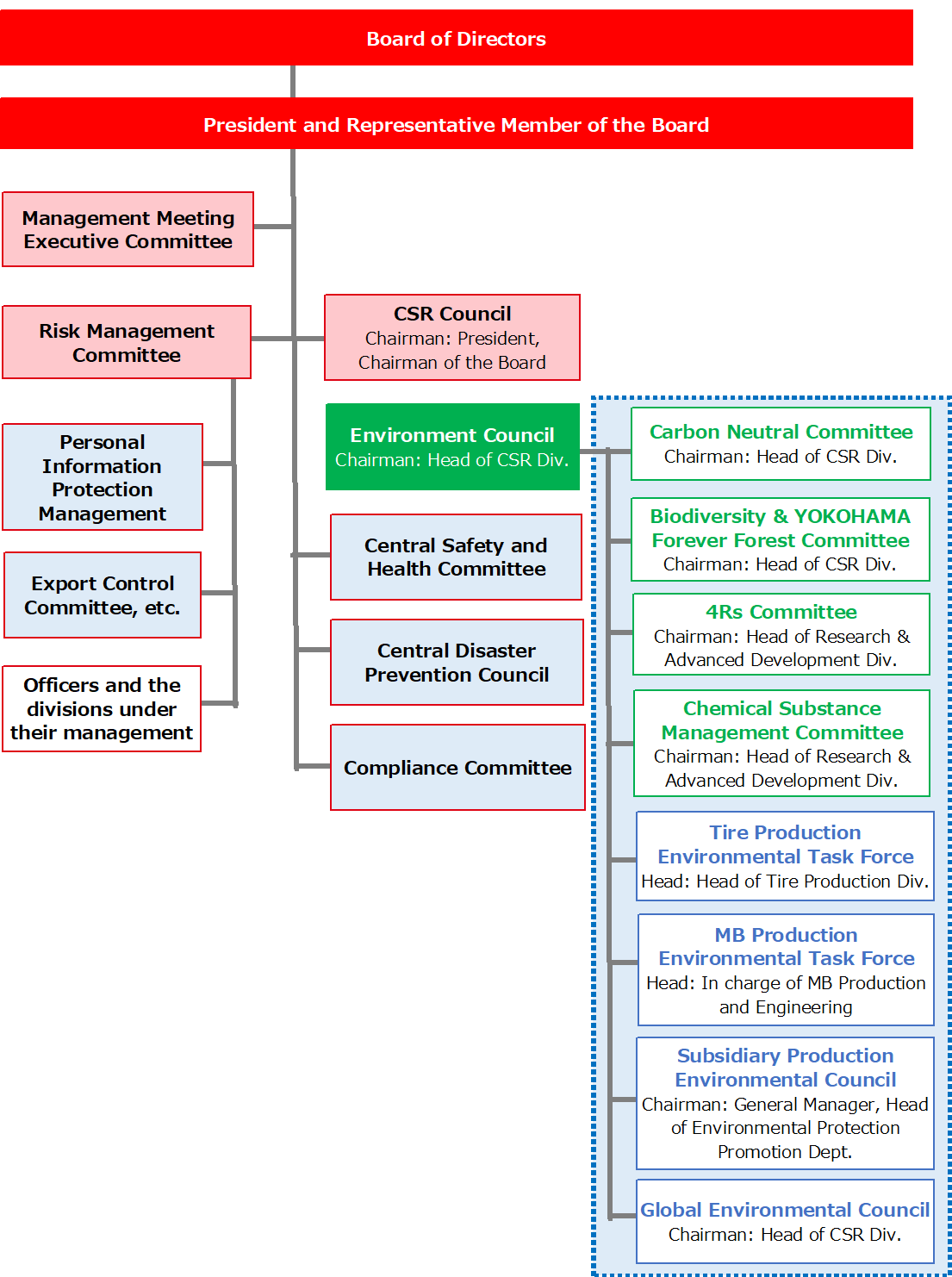Disclosure information on the recommendations of the Task Force on Climate-related Financial Disclosures (TCFD)
Responding to Challenges Related to Climate Change
Governance
Strategy Planning
Risk Management
Metrics and Targets
Responding to Challenges Related to Climate Change
In recent years, the effects of climate change have become increasingly severe, with frequent extreme weather events and natural disasters threatening the safety of people around the world.
Meanwhile, since the 2015 Conference of the Parties (COP21) to the United Nations Framework Convention on Climate Change (UNFCCC), which adopted the Paris Agreement, momentum for climate change mitigation and adaptation has been growing worldwide and companies are expected to proactively address climate change, including decarbonization.
The Yokohama Rubber Group has positioned "climate change mitigation and adaptation" as one of the key management issues for contributing to a sustainable society and sustainable corporate growth, and expressed its support for the TCFD recommendations in January 2022.
We will continue to actively disclose information on our efforts to address climate change in line with the TCFD recommendations.
Meanwhile, since the 2015 Conference of the Parties (COP21) to the United Nations Framework Convention on Climate Change (UNFCCC), which adopted the Paris Agreement, momentum for climate change mitigation and adaptation has been growing worldwide and companies are expected to proactively address climate change, including decarbonization.
The Yokohama Rubber Group has positioned "climate change mitigation and adaptation" as one of the key management issues for contributing to a sustainable society and sustainable corporate growth, and expressed its support for the TCFD recommendations in January 2022.
We will continue to actively disclose information on our efforts to address climate change in line with the TCFD recommendations.
Governance
The CSR Council, which is chaired by the President, Chairman of the Board, convenes twice a year (in May and November), and is positioned to draft and consider challenges related to climate change mitigation and adaptation, as well as other CSR challenges to be tackled by the Yokohama Group. Regarding climate change mitigation and adaptation, an Environment Council has been established. Environmental activities are pursued with the establishment of two task forces, two councils and four committees as subordinate bodies to the Environment Council. With an officer in charge (head of the CSR Div.) as its chairperson, the Environment Council deliberates and makes decisions regarding various issues such as carbon neutrality and oversees the environmental activities of the Yokohama Group.
Climate Change-Related Governance Support System

Strategy Planning
We have classified climate-related risks into two categories, specifically risks associated with the transition to a low-carbon economy (transition risks) and risks associated with the physical impacts of climate change (physical risks). We have also assessed the magnitude of the financial impacts to be affected and summarized the risks and opportunities for our business.
In addition, we conducted scenario analysis using the scenarios presented by the International Energy Agency (IEA) and the Intergovernmental Panel on Climate Change (IPCC) regarding temperature increase, and examined adaptation measures and financial impacts based on the risks and opportunities of the 1.5°C and 4°C scenarios, respectively.
We will continue to examine risks and opportunities and refine our scenario analysis.
In addition, we conducted scenario analysis using the scenarios presented by the International Energy Agency (IEA) and the Intergovernmental Panel on Climate Change (IPCC) regarding temperature increase, and examined adaptation measures and financial impacts based on the risks and opportunities of the 1.5°C and 4°C scenarios, respectively.
We will continue to examine risks and opportunities and refine our scenario analysis.
Major Risks and Opportunities Related to Climate Change
| Material Factors | Category | Potential Financial Impact | Impact | ||
|---|---|---|---|---|---|
| Risks | transition risks | Transition to a decarbonized society | Policy and Regulations | Introduction and rise of carbon pricing | Large |
| Markets | Resource (raw material) price hikes and supply instability | Large | |||
| Increase in renewable energy and fuel prices (crude oil, natural gas) | Large | ||||
| Technology | Capital investment to improve manufacturing process efficiency | Medium | |||
| Reputation | Impact on customer evaluation of emission reduction efforts and stance, and on stock price | Small | |||
| Response to the global movement to promote the use of renewable energy (reputation among stakeholders) | Small | ||||
| Change in demand for products and services | Markets | Product selection based on evaluation of CO2 emissions during manufacturing (competition within the same product) | Large | ||
| Response to changes in the automotive industry | Markets | Decline in car sales due to MaaS | Large | ||
| physical risks | Intense weather disasters due to rising temperatures | Acute | Raw material procurement difficulties and higher procurement costs due to supply chain disruptions | Large | |
| Equipment damage or shutdown due to extreme weather | Large | ||||
| Intense climate change | Chronic | Depletion of natural rubber (natural resources) due to climate change, making procurement difficult | Large | ||
| Decline in demand for winter tires due to reduced snowfall, etc. | Large | ||||
| Increased R&D investment required to improve product performance | Medium | ||||
| opportunities | Transition to a decarbonized society | Energy Sources | Reduce energy costs by improving manufacturing process efficiency | Medium | |
| Products and Services | Increase market share by responding quickly to changes in demand (carbon neutral compliance and performance requirements for electric vehicle (EV) installation) and stricter regulations. | Large | |||
| Change in demand for products and services | Products and Services | Improve competitiveness and profitability by offering environmentally friendly products using renewable/recycled raw materials and fuel-efficient, low-carbon products | Large | ||
| Response to changes in the automotive industry | Products and Services | Increased demand for products and services that support next-generation mobility
(CASE and MaaS compliance, new business opportunities through hydrogen utilization) |
Large | ||
| Climate change | Products and Services | Increased demand for products and services that contribute to disaster prevention, recovery, temperature change, food, and nature
(e.g., tires, oil fenders, etc. that contribute to crop/forest growth) |
Large | ||
Summary of Scenario Analysis Results
| Scenario Conditions | 1.5°C scenario | 4℃ scenario | |
|---|---|---|---|
| Scenario Overview | Limit the increase in the global average temperature to 1.5°C above pre-industrial levels by 2100 through stringent climate policies and technological innovation for sustainable development. | Failure of strict climate policies and technological innovation, and rapid intensification of the physical effects of climate change, resulting in a 4°C increase in average temperature by 2100 relative to pre-industrial levels. | |
| Reference Scenario | Transition risk | IEA
Net Zero Emissions by 2050 Scenario(NZE) |
IEA
World Energy Outlook 2021(WEO2021) |
| Physical Risk | IPCC 6th Report SSP1-1.9 | IPCC 6th Report SSP5-8.5 | |
| Analysis Results | Mainly transition risks/opportunities are manifested.
[Risks] Increased energy cost burden and capital investment to improve manufacturing process efficiency due to the need to comply with strict climate change regulations, procurement of renewable energy, and introduction of carbon pricing. Increased R&D and procurement cost burdens for renewable/recycled raw materials due to the increase in the number of products with reduced environmental impact. [Opportunities] Competitiveness and profitability will be enhanced through carbon neutral compliance, early response to EV-mounted performance requirements, and provision of environmentally friendly, fuel-efficient, and low-carbon products. |
Mainly physical risks/opportunities manifested.
[Risks] Increased occurrence of serious natural disasters at bases and in the supply chain. In addition, extreme weather conditions will deplete natural resources, making raw material supplies unstable. Product demand changes due to chronic climate change, such as lower demand for winter tires due to reduced snowfall, etc. [Opportunities] Increased demand for products and services for disaster prevention, recovery, and temperature fluctuations. |
|
Risk Management
Regarding risks related to climate change, subordinate organizations to the Environment Council, including the Carbon Neutrality Promotion Committee and other task forces, councils and committees identify and assess each risk and engage in activities to mitigate them. For the material risks identified by each task force, council or committee, the Environment Council deliberates and decides on countermeasures. For physical risks such as natural disasters, the Central Disaster Prevention Council is working on disaster prevention and BCP and promoting risk reduction. Matters of great seriousness and urgency are deliberated by the Risk Management Committee (chaired by the head of the Corporate Administration Div.), which was established to strengthen our defensive posture against the various risks that surround Yokohama and are appropriately evaluated and handled.
The activities of the Risk Management Committee are regularly reported to the Board of Directors.
The activities of other committees are reported to the Executive Committee as appropriate, and those deemed necessary are reported to the Board of Directors.
The activities of the Risk Management Committee are regularly reported to the Board of Directors.
The activities of other committees are reported to the Executive Committee as appropriate, and those deemed necessary are reported to the Board of Directors.
Metrics and Targets
In order to minimize risks related to climate change, we have set the following mid to long-term targets for our environmental activities.
| Item | Mid to Long-Term Targets |
|---|---|
| Carbon Neutral |
|
| Circular Economy |
|
| Coexistence with Nature |
|
On our Sustainability website, we disclose the results of each indicator such as GHG emissions, water, waste, and Forever Forest and biodiversity conservation activities. We will continue to update this information on a regular basis.
Please refer to the following link for further details.
Non-Financial Highlights


